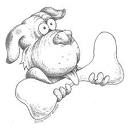Q. What do you recommend when it comes to dental hygiene?
A. Brushing your dog’s teeth is good, but I discovered that I get the same if not better results from letting them chew on raw bones. Raw knuckle bones (the joints) in particular are great because they are soft and still have some tendons and muscle meat attached. These bones clean your dog’s teeth and provide them with a nice oral workout – not to mention a dose of natural calcium.
Q. Should the bones be raw or cooked?
A. Raw knuckle bones are what I recommend rather. Cooked bones are more likely to splinter from the effect that high cooking temperatures have on them and cooked bones, especially the white sterilized bones from the pet stores, will also be lacking of beneficial nutrients which raw knuckle bones are full of. A further benefit of raw bones versus the white sterilized bones from the store, are that they taste great to your dog. This results in more chewing time from your dog both keeping him/her busy and better cleaning the teeth.
Q. Why knuckle bones and not some other types of bones?
A. Raw knuckle bones are soft and allow dogs of all sizes to scrape their teeth into the bone, nicely cleaning food and tartar from their teeth. The meat tissue typically still left on the bones allow for a separate type of chewing, which is natural and necessary for your dog. This is the nibbling and pulling you see your dog do with his front teeth. They will use their front teeth to pull the tissue off the bones which is a great way to clean these teeth – natural flossing, if you will. This is not to say dogs should never chew on anything else or any other type of bone. Satisfying the need to chew is very important whether or not it contributes to keeping the teeth clean. So while other bones may make fine chew toys, I don’t feel they serve the teeth cleaning purpose. One in particular that I don’t recommend for teeth cleaning (besides cooked or sterilized bones) is the femur bone, which ironically is the stereotypical “dog bone” shaped bone. While your dogs will enjoy raw femur bones, I find that they don’t do as good of a job at cleaning the teeth because generally dogs cannot scrape into the femur as easily as they can with the knuckle bone. I also find that the enjoyment doesn’t last as long as it does with a knuckle bone.
Q. Other chew items are marketed as being good for cleaning teeth. How do raw bones compare in price?
A. Knuckle bones from Blue Ridge Beef retail for about a $1.00 per pound, the adverage knuckle bone weighing less than 1 lb. That same bone, processed and packaged at the pet store may cost $5.00 and up. Nylabone also makes edible bones in flavors like peanut butter for instance, these can run about $4- $5 a piece, and they are consumed quickly.
Q. How often and for how long should I provide my dog with raw bones?
A. I let my dogs chew on them as long as they want. The first chewing session on a fresh bone typically lasts 30 - 60 minutes. I have had some dogs chew on them continuously for hours. Chewing is also great exercise for your dog. I find them very content and relaxed while chewing and ready for a nice rest afterwards.
Q. How should I store the bones when not in use?
A. When I get my bones they are frozen, they are stored in my freezer until I give them to the dogs. I usually thaw them or run warm water over them before feeding them. After the dog is finished chewing, if he leaves any meat on the bone, I would recommend it be put back in the freezer or refrigerator. If after the first chewing, the bone is pretty much cleaned up, then I let them stay out. Do not let the bones stay outside in warm weather if you do not want flies all over them.
Q. Is bone chewing messy?
A. Yes, definitely messy. You will want to keep your dog on a blanket or towel that can be easily washed, keep them outside, or better yet in their crate, which can be easily washed out. Once the bone has been chewed well, it is actually quite clean and I let my own dogs have them inside the house.
Just remember that veterinarians may still advocate regular brushing and annual dental care even for dogs that eat raw bones. Dogs with poor health or tooth quality can have tooth fractures when chewing on raw bones.
Good tooth and gum health can prevent bad breath, periodontal disease, discomfort and inflamed or infected gums, as well as more serious conditions such as kidney disease, liver disease, heart conditions and joint problems. Plaque and tartar can build on the teeth, offsetting the balance of good bacteria in the mouth, which leaves way for infection and disease to spread. Whether you brush the teeth, or allow your dog chew on raw knuckle bones daily, the important thing is removing the plaque and tartar regularly. Good oral hygine along with a healthy diet full of naturally-occurring nutrients will keep the immune system functioning, the good bacteria plentiful and make your dogs teeth shine.

Is feeding bones really good for my dogs teeth?
Nourish the beast inside your pet

Top
Pet Nutrition
 | ||||||
Pet Nutrition
Frequently
asked questions.
Click below for info on:
